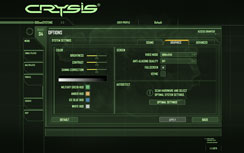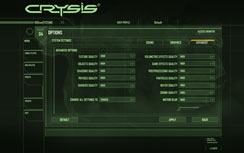Crysis
Publisher: Electronic ArtsCrysis is seen by many as the poster boy for DirectX 10 and it will make your system cry, quite literally – it’s a monster! It doesn’t come as much of a surprise then, that the graphics are something special – they’re above and beyond anything we’ve ever seen in a PC game.
We tested the game using the 64-bit executable under DirectX 10 mode with the 1.21 patch applied. We used a custom timedemo recorded from the Laws of Nature level which is more representative of gameplay than the built-in benchmark that renders things much faster than you're going to experience in game. We found that around 27-33 fps in our custom timedemo was sufficient enough to obtain a playable frame rate through the game. It's a little different to other games in that the low frame rates still appear to be quite smooth.
In addition to testing under DirectX 10 with all quality details set to High, we feel it's about time hardware should be able to handle the game with the in-game settings tuned to Very High. The game has been out for at least a year now, so it's time for hardware manufacturers to catch up with the software.
We forced 8x anisotropic filtering in the driver menu as there is currently no support for it in game and tested at 1,280 x 1,024, using 0x, 2x and 4x anti-aliasing, 1,680 x 1,050 using 0x and 4x anti-aliasing, 1,920 x 1,200 using 0x and 2xAA and 2,560 x 1,600 with 0xAA. By extensively testing using anti-aliasing in very high resolutions in conjunction with Very High quality in-game settings, we'll be pushing even the bleeding edge hardware on test to the limit.
Crysis run with the High detail settings shows pretty much the same picture as the Very High tests, though this time the Sapphire Vapor-X has a 1fps advantage over the 1GB HD 4870 at quite a few resolutions. We'd still put this down to margin of error, but it happens so consistently (at 1,280 x 1,024 with 4x AA; both 1,680 x 1,050 tests; both 1,920 x 1,200 tests; 2,560 x 1,600 with 0x AA) that we might just be ever so slightly tempted to say that the Sapphire Vapor-X is a teensy bit faster than a standard HD 4870 1GB card.
However, that's academic as the GeForce GTX 275 again walks all over the Vapor-X for performance. The Vapor-X cooler is much much quieter than the stock cooler of the GTX 275 though, a point we talk more about in the Thermal Performance page.

MSI MPG Velox 100R Chassis Review
October 14 2021 | 15:04












Want to comment? Please log in.